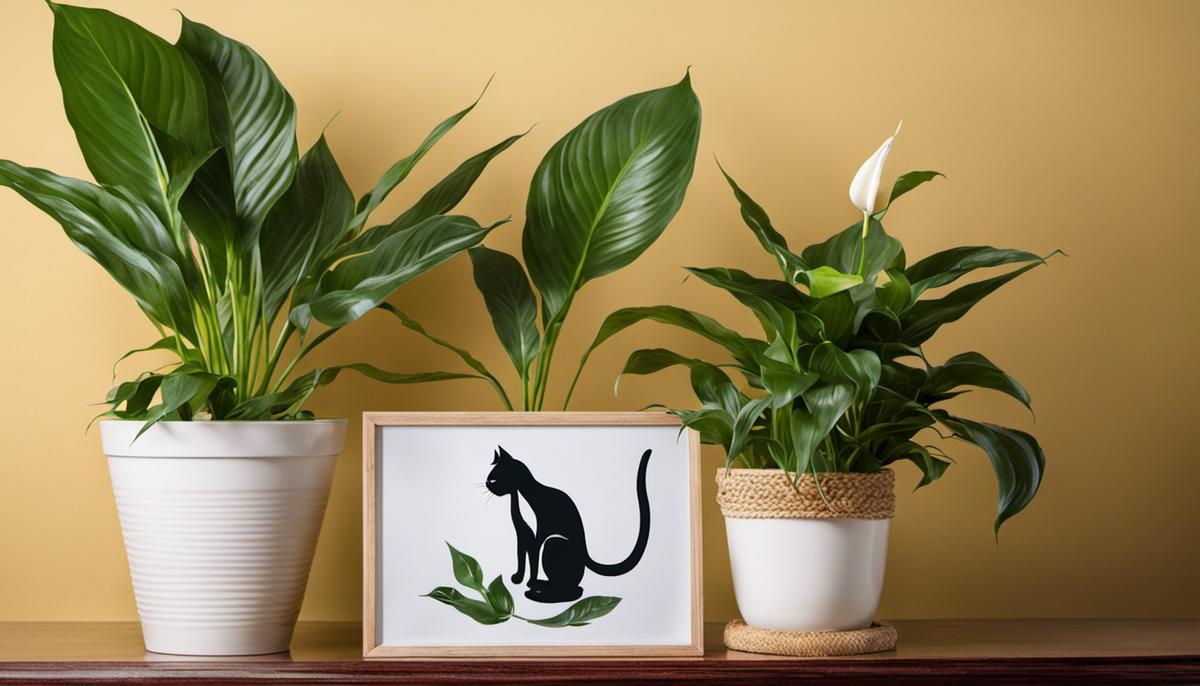Are Peace Lilies Harmful for Your Feline Friends?

Peace lilies, while beautiful and soothing to look at, hide a potentially dangerous secret for our feline companions. Their allure can be hazardous, if not deadly, to cats due to the presence of toxic chemicals, primarily calcium oxalate. This makes understanding the toxicity of peace lilies vital for those with cats in their homes. In the unfolding discourse, we delve into the science behind this toxicity and the disturbing symptoms it causes, providing insights into the issue in an accessible way for cat owners.
Understanding Peace Lily’s Toxicity
Who knew that a charming houseplant could pose a potential threat to our feline friends? As much as we all adore the charming ambiance peace lilies bring into our homes, it’s essential to understand that they can be harmful to our curious kitties. Scientifically known as Spathiphyllum, peace lilies, though not true lilies, contain a substance known as calcium oxalate. When ingested by cats, these crystals can cause less-than-peaceful reactions, including irritation of the mouth and gastrointestinal tract.
Calcium oxalate is not exclusively harmful to cats. The same substance found in peace lilies can affect humans and other pets, albeit not in the same way. Nevertheless, we might feel a mild tingling sensation if we make prolonged skin contact with the plant. For cats, however, symptoms can be more severe and immediate due to their natural curiosity and grooming habits. Once the peace lily is bitten, chewed, or swallowed, the crystals contained within can irritate and inflame the cat’s oral and throat tissue, leading to various symptoms like excessive drooling, difficulty swallowing, or even vomiting.
Moreover, cats are generally proficient self-groomers, meaning they might ingest the crystals while cleaning themselves after coming into contact with the plant. Therefore, it’s crucial for cat-owning houseplant enthusiasts to consider these factors when adding new greenery to their homes. It’s always wise to research each plant thoroughly before making a purchase, to ensure that the newest addition to our indoor garden won’t inadvertently trespass on our beloved pets’ territory. After all, the ultimate aim is not only to embellish our homes with greenery but to maintain a healthy and safe environment for all family members, including our cherished four-legged companions!

Preventing Cat Exposure to Peace Lilies
When it comes to protecting our feline friends from these seemingly harmless house plants, prevention truly is the best medicine. Though peace lilies may add a touch of elegance to your indoor decor, remember, their visual appeal can become a cat’s nemesis. Prudent steps should be taken to place your peace lilies, or any other plants containing calcium oxalate, in an area inaccessible to your cats. High shelves, rooms where cats are not allowed, or even outdoor spaces can serve as great locations for these plants. Keep in mind, even small amounts pose a threat, so keeping the peace lilies completely out of cats reach is the key.
Understanding our cats’ curious nature and proclivity to explore, is crucial for creating a cat-friendly environment. While preventive measures are necessary, emergencies may still occur. Therefore, it is essential to be prepared for such situations by having your vet’s contact details handy at all times. In instances where you suspect the cat might have come into contact with a peace lily, don’t hesitate to seek medical attention immediately. Additionally, have a conversation with your vet about peace lilies and other potentially harmful plants, to better understand the risks involved.
Remember, our aim is to not only create a cozy and remarkable home for ourselves, but equally important is providing a safe haven for our furry family members. Numerous houseplants can provide beauty and clean air without posing a risk to your pets. Let’s make sure to choose wisely and keep the wellbeing of our entire family, including our beloved cats, at the forefront of our decisions.

Emergency Actions and Vet Consultations
If the dreaded happens and your meticulous measures fail – revealing that your beloved fur baby has indeed consumed a bit of peace lily, swift action is paramount. Knowing what to do in this emergency situation can mean all the difference. Carry your cat gently to a well-lit area, ensure its comfort and take note of its symptoms. Following this, you must immediately contact your vet or, better yet, rush your companion to a nearby animal emergency room, as every minute counts.
Providing detailed information to the vet will be crucial for the correct procedure to be performed for your feline friend. Keep them informed about how much of the plant your cat may have ingested and also present a thorough description of the symptoms up till the present moment. This will allow them to understand the severity of the situation and decide upon the best form of treatment.
In the aftermath, it is worthy to consider a discussion about the incident with your vet once your fur baby has recovered. Talk about how to ensure it won’t happen again, and get recommendations for cat-safe plants to fill your home with instead. That way, your family and pets can coexist comfortably in your beautiful, green-filled home. Above all, remember that as fur parents, our goal is to create a loving and safe environment for our pets, where they can live their nine lives to the fullest.

While peace lilies bestow an ethereal beauty to your surroundings, it is essential to approach their presence in a home with cats with caution and knowledge. Understanding the plant’s toxicity, recognizing the signs of poisoning, taking preventive measures, and knowing what to do in emergencies can be a lifesaver. By translating this understanding into practical steps, we all can ensure that our love for greenery does not in any way jeopardize the health and happiness of our fuzzy friends.



